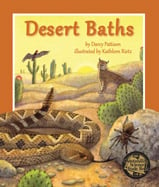Alignment to Standards for NM

| Grade | Number | Standard |
|---|---|---|
| 1 | GEO-1)2.A.1 | Understand maps and globes as representations of places and phenomena. |
| 1 | GEO-1)2.D.1 | Describe the Earth-Sun relationship and how it affects living conditions on Earth. |
| 1 | SC-1)2.2.1.2. | living organisms inhabit various environments and have various external features to help them satisfy their needs (e.g., leaves, legs, claws). |
| 1 | SC-1)2.2.1.3. | differences and similarities among living organisms (e.g., plants, animals). |
| 1 | SC-1)2.2.3.1. | simple body functions (e.g., breathing, eating, sleeping) |
| 1 | SC-1)2.2.3.3. | some parts of human bodies differ from similar parts of other animals (hands and feet/paws; ears). |
| 1 | SC-1)2.3.1.1. | changes that occur in the sky as day changes into night and night into day. |
| 1 | SC-1)2.3.1.2. | the basic patterns of objects as they move through the sky: |
| 1 | SC-1)2.3.1.2.a | sun appears in the day |
| 1 | SC-1)2.3.1.2.c | sun and moon appear to move across the sky |
| 1 | SC-1)2.3.1.3. | the sun, moon, and stars all appear to move slowly across the sky. |
| 1 | SC-1)2.3.2.2. | different climates (e.g., desert, arctic, rainforest). |
| 2 | GEO-2)2.A.1. | Use a variety of maps to locate specific places and regions. |
| 2 | GEO-2)2.A.2 | Identify major landforms, bodies of water, and other places of significance in selected countries, continents, and oceans. |
| 2 | SC-2)2.2.2.3. | the environment influences some characteristics of living things (e.g., amount of sunlight required for plant growth). |
| 3 | GEO-3)2.A1 | Identify and use the mapping tools of scale, compass rose, grid, symbols, and mental mapping to locate and draw places on maps and globes. |
| 3 | SC-3)2.2.1.1. | an adaptation in physical structure or behavior can improve an organismês chance for survival (e.g., horned toads, chameleons, cacti, mushrooms). |
| 3 | SC-3)2.2.1.2. | plants and animals have structures that serve different functions (e.g., shape of animalsê teeth). |
| 3 | SC-3)2.2.1.3. | Classify common animals according to their observable characteristics (e.g., body coverings, structure). |
| 4 | GEO-4)2.D.2 | four provinces (plains, mountains, plateau, and basin and range) that make up New Mexicoês land surface (geographic conditions). |
| 4 | SC-4)2.2.1.1. | different living organisms have distinctive structures and body systems that serve specific functions (e.g., walking, flying, swimming). |
| 4 | SC-4)2.2.2.2. | a change in physical structure or behavior can improve an organismês chance of survival (e.g., a chameleon changes color, a turtle pulls its head into its shell, a plant grows toward the light). |
| K | GEO-K)2.B.1 | Identify natural characteristics of places (e.g., climate, topography). |
| K | GEO-K)2.C.2 | natural characteristics of places: landforms, bodies of water, natural resources, and weather). |
| K | SC-K)2.2.1.1. | major structures of common livings organisms (e.g., stems, leaves, and roots of plants; arms, wings, and legs of animals). |
| K | SC-K)2.2.2.1. | similarities and differences in the appearance and behavior of living organisms (e.g., plants, animals). |
| K | SC-K)2.3.1.2. | the location and movements of objects in the sky (e.g., stars, sun, moon). |